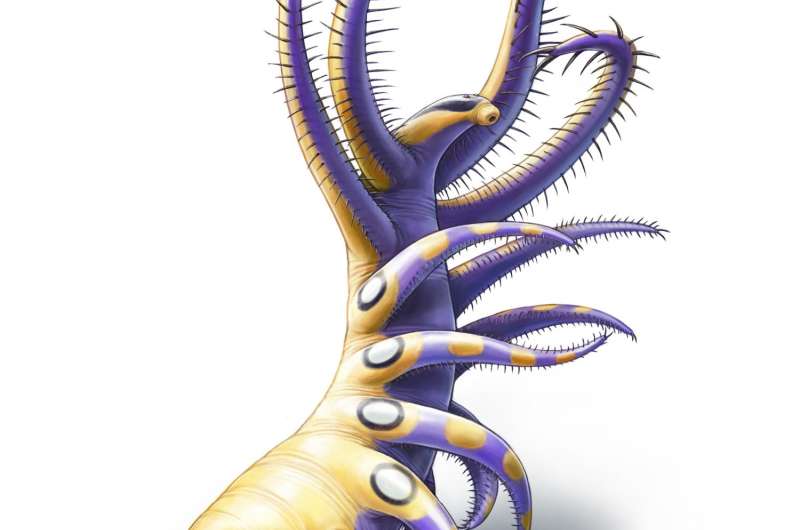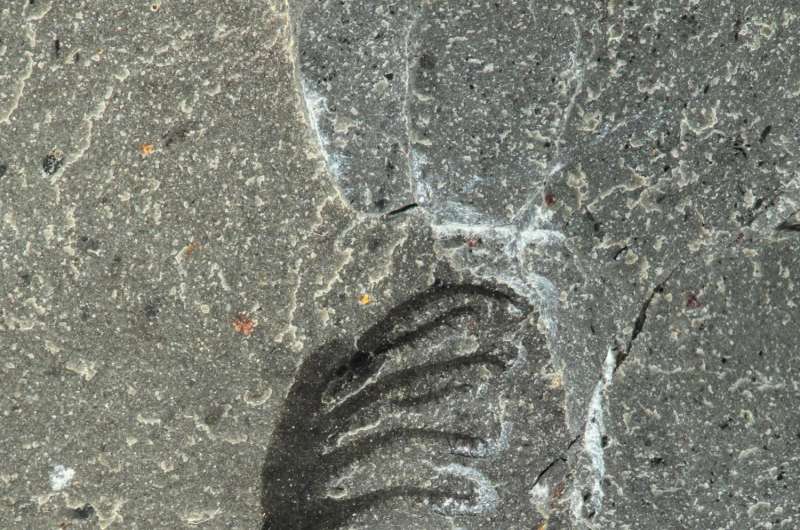A scientificillustration of Ovatiovermis cribratusshows how this soft-bodied marine animal would have looked like with its front feeding limbs extended. Credit: Illustrated by Danielle Dufault, Royal Ontario Museum© Royal Ontario Museum
A new species of lobopodian, a worm-like animal with soft legs from the Cambrian period (541 to 485 million years ago), has been described for the first time from fossils found in the Burgess Shale in the Canadian Rocky Mountains. Details of the new species, called Ovatiovermis cribratus, are being published in the open access journal BMC Evolutionary Biology this week.
Dr Jean-Bernard Caron, senior curator of invertebrate paleontology at Royal Ontario Museum (ROM), associate professor at the University of Toronto in the Departments of Earth Sciences and Ecology & Evolutionary Biology, and lead author of the study, said: "Ovatiovermis is no longer than my thumb with all limbs stretched out and is only known from two specimens. However this new species provides fantastic new insights into the ecology and relationship of lobopodians, a group of mainly Cambrian marine invertebrates which are key to our understanding of modern tardigrades, onychophorans and the largest group of animals on Earth—the arthropods."
The researchers believe that strong recurved claws on the back limbs may have allowed Ovatiovermis and other related lobopodian species to anchor themselves on hard surfaces and stand more or less upright. Two long pairs of spinulose (hairy or spiky) limbs towards the front of the body would then have been used to filter or collect food from water and bring it closer to the animals' mouth.
Animation ofOvatiovermis cribratusdepictinghow the animal would have used its upper limbs to filter small food particles in the water column while holding on to a sea sponge by its lower set of limbs. Credit: Animated by Lars Fields,Phlesch Bubble Productions © Royal Ontario Museum
Cédric Aria, a doctoral candidate from the Department of Ecology & Evolutionary Biology at the University of Toronto and co-author of the study, explained: "The various adaptations of this new animal to anchored particle feeding are reflected in its name. The species, cribratus, is the Latin for 'to sieve', while the genus name, Ovatiovermis, refers to that posture it must have ordinarily adopted: a worm-like creature that stood in perpetual ovation."
Even though lobopodians have long been known and studied, and occupy an intriguing position in the tree of life of invertebrate animals, their ecology had remained poorly understood. The authors of the study believe that their findings provide new views on the evolution of lobopodians and their relatives.
Aria added: "We think that suspension feeding was common among lobopodians and turned out to be important in the initial evolutionary 'burst' of that colossal group of organisms that gave rise to water bears, velvet worms and arthropods. Interestingly, today, skeleton shrimps (Caprellidae), which are arthropods and thus much more complex living relatives of the lobopodians, have adopted a very similar lifestyle, and you can see them waving in the drifting water possibly much like Ovatiovermis used to. "
The second known fossil of Ovatiovermis cribratusis seen here more fully exposed after layers of rock that partially covered the fossil were removed at the ROM’s invertebrate palaeontology lab in 2016. Specimen id: ROM 64006. Credit: Jean-Bernard Caron© Royal Ontario Museum
Dr. Caron further stated: "These results contribute further evidence that suspension feeding was already a widespread mode of life during the Cambrian period. Its emergence has been important for the origin of modern marine ecosystems, and must have played a role in the rapid diversification of the first animals. "
The researchers were surprised to find that unlike other suspension feeding organisms, O. cribratus, did not have any hard structures to protect its body. Dr Caron said: "Contrary to its relatives, this species does not have any spines or plates on its body for protection. Its 'naked' state begs the question of how it was able to guard against predators."
The lack of body protection in O. cribratus demonstrates that organisms that lived in the Cambrian period did not exclusively develop hard defensive structures. The researchers speculate that O. cribratus may have lived in sponge colonies to avoid predators, or that by analogy with modern animals it used camouflage or was toxic or distasteful to predators. "However, this is a question that is difficult to solve with fossils, and it may remain forever one of Ovatiovermis' secrets," Dr Caron added.
The new species is only the third lobopodian that has been formally described from the famous Burgess Shale site in Yoho National Park (British Columbia). It is one of the rarest species found there, and the only two known specimens of this species are now in the collections of the Royal Ontario Museum in Toronto.
More information: Jean-Bernard Caron et al, Cambrian suspension-feeding lobopodians and the early radiation of panarthropods, BMC Evolutionary Biology (2017). DOI: 10.1186/s12862-016-0858-y
Journal information: BMC Evolutionary Biology
Provided by BioMed Central

























